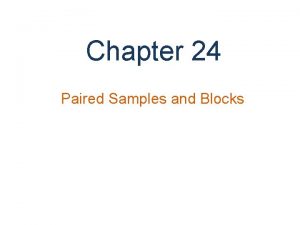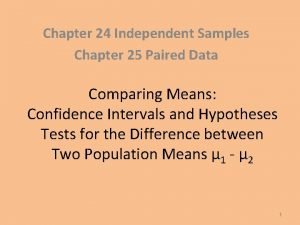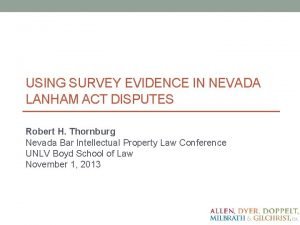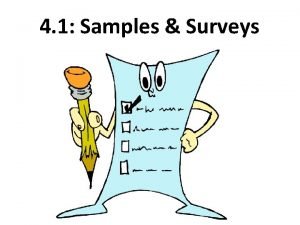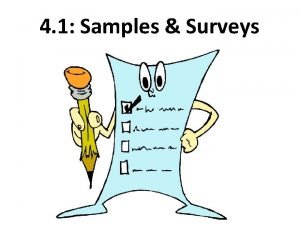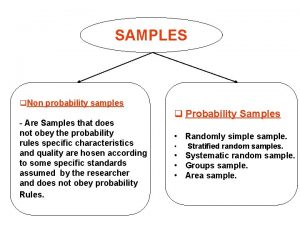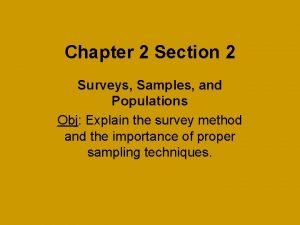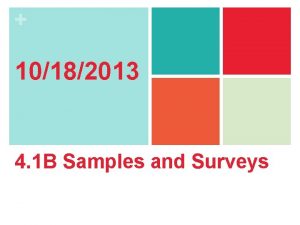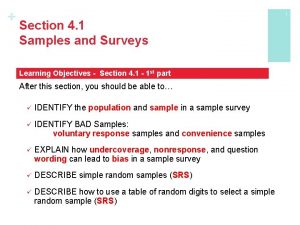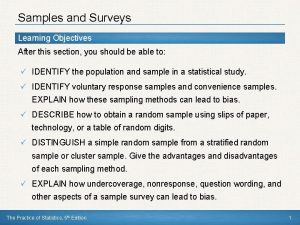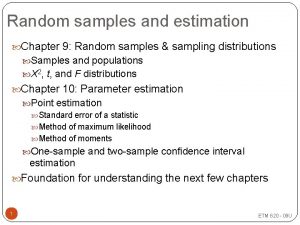Psychology Chapter 2 Section 2 Notes Surveys Samples












- Slides: 12

Psychology Chapter 2 Section 2 Notes – Survey’s, Samples, and Populations

The Survey Method In a survey, people are asked to respond to a series of questions about a particular subject.

Psychologists D. L. Dubois and B. J. Hirsh used the survey method to examine mixed-race friendships among high school students. More than 80 percent of White and African American students reported having a friend of the other race.

By distributing questionnaires or by conducting interviews over the telephone or in person, researchers can rapidly survey thousands of people. The findings of interviews and questionnaires are not necessarily completely accurate. People may not be honest, for whatever reasons, about their attitudes or behavior.

Populations and Samples When researchers conduct any type of study, they must consider what group or groups of people they wish to examine and how respondents will be selected. This is particularly true with surveys.

To accurately predict an outcome, it is necessary to study a group that represents the target population. A target population is the whole group you want to study or describe.

Selecting Samples Psychologists and other scientists select samples scientifically to ensure that the samples represent the populations they are supposed to represent.

One way that scientists try to obtain a sample that represents the target population is by using a random sample. In a random sample, individuals are selected by chance from the target population.

Researchers can also use a stratified sample. In a stratified sample, subgroups in the population are represented proportionally in the sample.

Generalizing Results Sometimes for one reason or another, researchers do not use a sample that represents an entire population. In some cases, the researchers want to know only one group within the population and have no reason to study other groups.

In such cases, researchers are cautious about generalizing their findings to groups other than those from which their samples were drawn.

Volunteer Bias People who volunteer to participate in research studies often differ from people who do not. Volunteers are usually more willing than other people to disclose personal information.
 Frustration aggression principle
Frustration aggression principle Chapter 24 paired samples and blocks
Chapter 24 paired samples and blocks Chapter 25 paired samples and blocks
Chapter 25 paired samples and blocks Chapter 25 paired samples and blocks
Chapter 25 paired samples and blocks Chapter 2 psychological methods
Chapter 2 psychological methods Lanham act surveys
Lanham act surveys Snap survey software
Snap survey software Real eyes surveys
Real eyes surveys Survey vs observational study
Survey vs observational study Survey rebuttals
Survey rebuttals Security survey is also known as.
Security survey is also known as. Literature survey in research
Literature survey in research Surveys.panoramaed.com/everett
Surveys.panoramaed.com/everett

